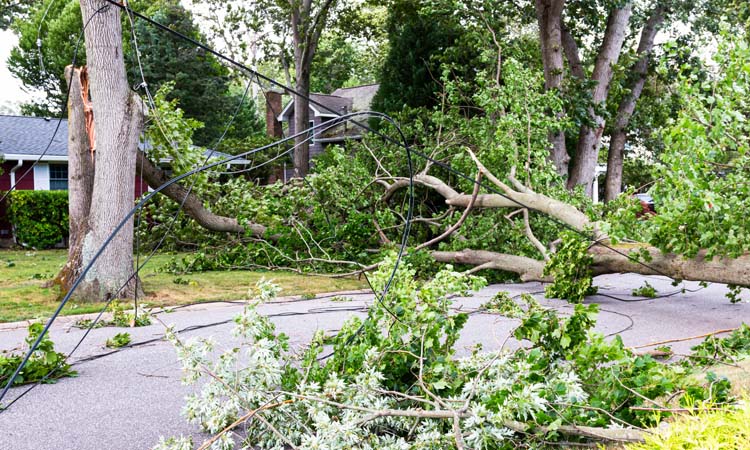CORE Electric Cooperative maintains an aggressive vegetation management program to minimize fire risk and outages. We work year-round to clear overhead distribution lines within our 5,000-square-mile service area and address member reports of hazardous vegetation.

Vegetation management along overhead distribution and transmission line rights of way helps reduce power outages for our members and enhances safety for our members, employees and contractors. We use an inspection process that identifies vegetation that could be a hazard to the lines and ensures that vegetation management activities follow our pruning and clearance specifications.
With over 5,000 miles of overhead lines across the service territory, scheduled pruning and hazard tree removal is spread out during a 6-year cycle where we visit every distribution circuit at least once. To ensure that vegetation does not interfere with the power lines before the next inspection, pruning specifications require a clearance of 10 to 24 feet, depending on species.
If your area is scheduled to be inspected and maintained, you will receive a letter in the mail notifying you prior to work. You will then be contacted by our pre-inspectors to discuss the work prior to it being performed.
CORE uses qualified line clearance contractors to perform much of our vegetation management work. Trucks and crews performing these tasks in your community will display ‘CORE Contractor’ decals on their trucks. These contractors are required to follow industry standards and guidelines for safety, quality and tree health. Members, property owners, and untrained contractors should not prune or cut trees and plants near power lines.
Please contact us at (800) 332-9540 if you see a potentially hazardous tree or other vegetation concern that threatens our power lines. We will assess the risk posed to our equipment and, if necessary, remove the potential hazard at no cost to you. You may also contact us with any questions, comments or concerns about the vegetation management program.
Explore our frequently asked questions to learn more:
What happens to the wood or trimmed trees after trimming?
Green slash from trees trimmed away from the lines is typically chipped and hauled away or broadcast back into the right-of-way. When live trees are removed, the green slash is chipped, and the logs are cut and stacked. All debris, material, and wood from dead hazard tree removals will be cut and stacked and will remain on site. The property owner is responsible for further removal.
How long does it take for my tree request on my property to be completed?
It is hard to give an exact time since we do prioritize jobs depending on the severity of the hazard. Additionally, crew workload and availability may fluctuate throughout the year, but most tree issues are mitigated in 6-8 weeks.
What is my responsibility as a homeowner?
• Members are responsible for reporting obstructions in secondary lines. These are typically single lines stretching from our pole to a members’ home. Obstructions can look like visible tension or abrasion on the electric service line – usually a grey and black braided cable connecting to your home. This includes fully dead trees that are completely brown, have no leaves or are losing needles and appear to be tall enough to hit our lines and other equipment if they fall.
• CORE is responsible for trimming around primary lines. These are lines running from pole to pole. CORE maintains these because they are high-voltage and require special handling from a qualified tree trimming crew. Please do not attempt to remove anything in contact with power lines.
What should I be aware of when planting trees or other vegetation?
• Do not plant trees or shrubs within 10 feet of the front of underground transformers, or 4 feet on other sides.
• Do not plant trees within the right-of-way surrounding overhead transmission lines, or any tree expected to grow beyond 10 feet within the right-of-way surrounding overhead distribution lines.
• Plant trees at least 20 feet from distribution or transmission poles and structures. Please see a list of recommended tree species to be planted in our Rights-of-Way Planting Guidelines.
• Call Colorado 811 before you dig.
• Do not trim trees yourself that are near an energized conductor. Contact CORE to have them professionally trimmed.
What part of the electrical equipment am I seeing on my property?
Visit this page to learn more about our pole equipment. Members should be aware of any trees causing tension on any of the equipment pictured except for the phone and TV cable lines which are usually the lowest hanging black lines. These lines are not operated by CORE.
Why aren't more power lines underground?
There are advantages and disadvantages to undergrounding electric distribution lines. While underground lines are protected from outages due to ice/snow, wind, and trees, they are also up to 10 times more expensive to install. Additionally, if outages do occur along underground cables, it takes much longer to find the problem, fix the lines, and restore power to our members.
CORE does work to put lines underground where appropriate, but in much of our service territory the terrain is much too rocky to do this work at a fiscally responsible cost to our members. Our comprehensive vegetation management program is the best, most cost-efficient and effective method to help prevent power outages.
